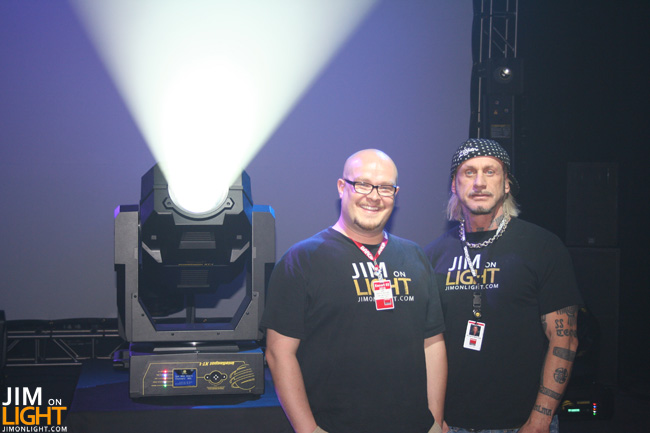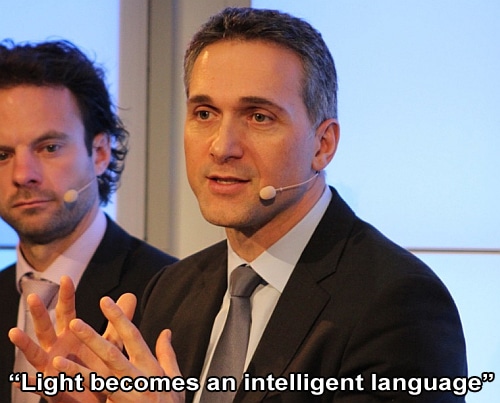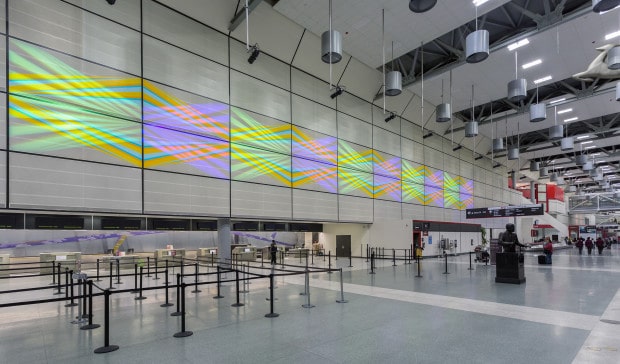
Friday was an amazing day. I have had a bunch of those lately, and life has never been better. Folks, we are making the future better! GO US!

(and HEY! Richard Belliveau still has his JimOnLight.com shirt from LDI 2009!)
A trusted American lighting company is also changing the future. Friday was an amazing day because I got to hang out with the family of outstanding folks at High End Systems in Austin, and I got to finally set my hands on the new Richard Belliveau baby that will soon become a full-grown bad mamma jamma – the Intellaspot XT-1 from High End Systems.
That’s right, I went there.
The Intellaspot XT-1 got some press on JimOnLight.com a few weeks ago when High End posted the video with Brad Schiller and Richard Belliveau talking about the Intellaspot XT-1. It’s bright, it’s got a sexy mechanical look, it’s got usability at its root purpose, and – it’s bright. What is absolutely unbelievable about the fixture is that not only is it bright, but it’s 20,000 lumens bright, on a lamp that sips on 850 watts. Did I mention that the Intellaspot XT-1 is variable from 100V to 240V?
(For those of you just tuning in, the Intellaspot XT-1 is putting out 20,000 lumens on a lamp that consumes 850 watts, even when you plug it into the wall.)
Okay, holy cow. Never mind the features of the Intellaspot XT-1 for a moment – when I taught in Texas, our main venue didn’t even have as much as a 208V company switch to use moving lights or motors. I constantly dreamed about the days when that might show up in the venue. Now there’s a moving light that is bright, feature packed, and I can switch out a few of the Sensor dimmer modules and stick in a few constant current modules for moving lights, without as much as the smell of three-phase circuits. How’s that taste, world? You can thank Richard Belliveau and his team of High End Systems rockstars for that meal.
I got a demo this last Friday when I was at the High End Systems facility in Austin – I got one of Brad Schiller’s outstanding demos to music with the fixture, then Brad stepped me through the different features of the Intellaspot XT-1. When you first see the fixture, you’re going to notice the big 8″ aperture slamming a beautiful beam of light through the atmosphere. The objective set itself is pretty hot in general – a static front lens, bumpers in front of it for those times when you accidentally drag the thing on the ground at 3am loadouts, and the condensing lens has the fixture name inside on the lens carriage. It looks pretty tight. Generally, the fixture has a sleek, mechanical look to it – I can see it playing well on broadcast television events too. It just looks good. You know, like a Corvette just looks good?
Intellaspot guts – Intellaspot XT-1 has 14 rotating gobos, all glass. The stock gobos are a pretty cool range too – including a rockin’ skull, great aerials, litho patterns, and foliage breakups. The gamut is covered, it almost has to be in the case of a moving light today being competitive. A gobo animation system is also included in the Intellaspot XT-1 – this is the same gobo animation system that High End has patented, and that we saw first in the Showgun. It is visually stunning – Brad had a few just unreal looks programmed with the gobos and animations playing together. He had walls melting, water running, and the whole studio visually on fire with the gobo animation system. Intellaspot XT-1 also has a four-facet prism that itself creates some pretty stunning looks – my complaint with prisms normally is that they’re never terribly specular (at least to my eye), and they always have some type of abberation (also, to my eye). Not this time – the prism in the XT-1 is clear, seems optically sound, and makes some nice effects tied with gobo rotation and animation.
Intellaspot XT-1’s color wheels are one fixed with five spots and open, full CMY mixing, and variable CTO. The color wheels are fast – with that big eight inch aperture, rolling color effects with the wheels are out of this world in my eyes. When Richard had the fixture open, I saw the static color wheel and how easy their system of usability with respect to the static color wheel was – the chips pull directly out and snap right back into place like it was just meant to happen that way. I’ll expunge more about usability here shortly, but there are more features I have to talk about first!
Iris, pan/tilt, strobe, zoom, optics, and the actual mechanics of the fixture are all standard features of moving lights today to stay competitive, but there is that extra bump of R&D on the Intellaspot XT-1 that pushes it to a level of professionality and grace that I expect when I’m designing. Intellaspot XT-1’s iris is clean, and when it narrows down to a pencil-thin beam slamming through that front aperture, it’s like a laser beam from that old movie Real Genius with Val Kilmer. Zoom and optics? Fluid, with 5:1 zoom. Scott Blair from High End was there at the demo as well (and gave me an excellent tour afterwards where we talked nerd), and he and Richard explained about the lens system that Intellaspot XT-1 uses – the lenses are sealed with an o-ring between them to keep the environment clean and specular, because we know what happens to optics when dirt and haze fluid gets into the light field.
Intellaspot XT-1 also has both types of strobing – electronic (via the ballast) and actual physical, mechanical strobing within the light field.
Pan and tilt and the general movement of the fixture is fast and smooth, and this is attributed to the excellent weight balance that the XT-1 has – it looks like a large fixture until it moves around, then it reminds me of the stealthy movements of a VL6 from back in the day in spirit. When a fixture is unbalanced, even a little, (and maybe I’m the only weirdo to notice this) but when it gets to around 75% tilt and is panning, and you try to snap the tilt back around, there is a slightly noticeable disconnect between the physics of the pan motion and the physical motion of the tilt. Does that make any sense? It almost look like a person was running and they immediately turned around and tried to go the other way without calculating the second or two it takes to stop their forward motion. A handful of the larger moving heads in our industry seem to exhibit this trait – Intellaspot XT-1 does not – its pan and tilt motor acuity seems very in sync. Pan and tilt movements are fluid and smooth, and between the front and back ends of the head itself, balance seemed to be perfectly achieved.
(I really, really hope some of that last paragraph made sense.)
Something that I believe in within our industry is usability. If you make the best fixture in the world, brighter than anything else, and it makes cappuccinos for the rest of the moving lights on the truss, it is only as good as the access it gives to the people who need to interface with it. Remember, moving lights are really just little robot people waiting on you to give them instructions to execute. If your techs and designers cannot use the fixture because you have not thought about the best way to have a human interface your fixture, you have failed at making that fixture. In the case of Intellaspot XT-1, this is the exact opposite. High End Systems has had a fixture in shows all over the globe on the road for decades – their wealth of experience in build and repair is extensive to say the least. Intellaspot XT-1 not only has amazing features, but working on those features should they ever need fixing (which everything does at some point) is easy and painless. The only way I can think of to tell about some of these features is a bulleted list – I hope that will suffice:
- Body covers. Intellaspot XT-1’s body covers (upper enclosure lids, head covers, arm covers) all have captive screws embedded in the covers so you don’t bounce one off of the ground 60 feet down while you’re on the truss. They’re also all tabbed so that you can fit them in place and they stay in place without a deviation from being aligned.
- Access to inside. Not only does the fixture have some room to get to components inside, but you can open the upper enclosure of the fixture via two panels on the top, and two panels on the sides of the upper enclosure. This is monumental. (For those of you who keep asking what the hell I mean by “upper enclosure,” it’s the part of a moving light on the other side of the head – imagine the fixture upside down – the upper enclosure is where the power, status lights, DMX or ethernet, and all that stuff lives.)
- Modularity. Pull two screws, you pull out the gobo wheels from the bulkhead. Pull two more screws, you pull out the color wheel. Power supplies in the upper enclosure? They pull right out in their sleds. Everything is accessible, and with ease. Richard says, and I’m paraphrasing, “We know how it is. We have to pull the stuff out too!” I can’t wait until JimOnLight.com readers get to take one of these apart. It is beautiful. David at High End had all of the covers off in under a minute, I secretly timed him! The best part? He used one screwdriver bit. For everything.
- Balance in handling. This is a major item for me – a lot of people who read JimOnLight.com are out there working, designing, loading in and loading out daily. To date, I have had my hands on every new “large aperture” moving light on the market. I’ve flipped each of them over and put them into their custom-designed cases, both in showrooms and in production situations. I asked to flip the Intellaspot XT-1 with Richard at the demo, and by far, it is the most weight balanced moving light I’ve touched. After doing it once, I asked Richard: “Can I do that again?” I had to be sure. We flipped it back up onto the table. We flipped it to the case. We flipped it out of the case and onto the floor, and then from the floor to the table, and back to the case. I had to be sure. I’m sure – its handles are smooth, thick, and easy to grasp – and the handles embedded in the yoke arms not only retract flush, but they are at the balance sweet spot. Intellaspot XT-1’s case has a design with ease of use in mind – the fixtures can come right off the truss and slide right into the case, one motion. I did not scrape my knuckles once handling the XT-1. I had a pretty rough knuckles experience with 12 other industry fixtures recently, and the XT-1’s handling is fast, effortless, and smooth.
- Price point. Intellaspot XT-1 is going to have an MSRP of $12,650. This is MSRP, not your dealer price, which will always be more awesome. What this means is that Intellaspot XT-1 is priced to be competitive; it’s on par with most of the current pricing out there, and way better than some of the industry-standard heads.
- Address with no power. How many times have you needed to get your FOH truss units addressed before they flew? How many times have you needed to get things set up with no power, and time was of the essence? Yeah, every time. Intellaspot XT-1 has a battery power unit for the display and “brain” that stores DMX addresses and setup functionality. The cooler thing is that if you lose the battery power, the fixture still works. This isn’t the case with some industry fixtures. In XT-1, if the battery does die, all you do is take off the front cover and replace the three AA rechargables with whatever AA batteries you got, and pow – addressing time again.
Folks, Intellaspot XT-1 is coming. Listen up – I’ll post new info as soon as I get it. I’m so grateful to have seen this fixture.





Comments are closed.